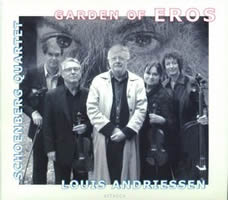Andriessen at 70 II
|
Dan Albertson [December 2009.] [Following the model of Rihm III, Andriessen II is somewhat curtailed. I thank Mirjam Zegers, as ever, and Denise Anderson, again. I also thank Ron Hevener for his generosity. Last, I send gratitude to Vic the postman and the manifold other kind souls in and near Delton for serving as useful Charons to my cicerone and me. This destination was mercifully milder than Hades, or so I imagine. D.A.] Louis ANDRIESSEN: La commedia (2004-08). Five parts, c. 105 mins. Privately circulated DVD. Andriessen has mounted theatrical works in multiple parts before. A surprising formality, a dearth of “good tunes” and too much jocularity are the largest flaws of this latest example. The composer has written of the “irony” of Dante Alighieri being especially relevant to him, so maybe the frivolity is in good fun, but I missed it. He also notes, “any music can express any text.” True enough. I only listened to the DVD, I confess; for III I will watch as well and perhaps then come to understand some of the frequent rattling and rustling noises not far from the world of tape collages. No judgment on director Hal Hartley until then. Part one, The City of Dis or: The Ship of Fools, has a jaunty opening but the chorus that soon enters is weak. Despite some trademark woodblocks and low clarinets, the musical argument plods. Slowing down for the entry of the soprano, aka Berenice, is no help. I am not sure what she is singing. Comments on Racconto dall’inferno, the first part completed, can be found here. I appreciate its sustained strings more in context than in isolation. The third part, Lucifer, has a suitably brash opening. Some unexpected sotto voce choral murmurs along the way. After turbulence from the ensemble, Lucifer emerges, speaking Dutch, which is also a surprise. He seems a tipsy braggart, not so much a surprise. Is he, in fact, Joost van den Vondel? Hi-hat accompaniment à la Weill, maybe? Not my métier. Inferno having been left behind, a typical Andriessen ostinato on clarinets, piano and bass guitar heralds The Garden of Earthly Delights. Faux Debussy on flutes was a brief shock and, in general, the jazz seems less ebullient, an effervescent trumpet aside, than in previous Andriessen incarnations. Momentum is quickly lost. The “film opera” ends quietly with Luce Eterna, the text from the end of Paradiso, but not used to much import. As in part four of De Materie, plaintive tintinnabulation reigns here. Too many intrusions prevail, such as another Dutch speaker, which puzzle rather than amuse. Fine vocal writing as the work nears the end, but then the end, as in ROSA, is not the end. Applause begins, only to be interrupted by brass music with children’s voices. More applause. The end. I think. In all, decent music much of the time, and consistently superb singing, but without the Andriessen panache.
Louis ANDRIESSEN: Quartet in two movements (1957); Facing Death (1990); Tuin van Eros (2002); …miserere… (2006); BACH / STRAVINSKY / ANDRIESSEN: Johann Sebastian Bach’s Prelude in B minor from The Well-Tempered Clavier BWV 869 (2006). Schoenberg Kwartet: Janneke van der Meer, Wim de Jong (vlns), Henk Guittart (vla), Viola de Hoog (vc). Attacca ATT 29121 (http://www.attacca-records.com/). More surprises. First, the 18-year-old composer’s string quartet, only recently restored to the catalogue. Maybe age has made him less self-conscious. Its movements are Lento (ma molto energico) and Presto, with the former being much more impressive, comfortable in its post-Debussy soundworld. The latter seems ill at ease and mannered in its rhythms. Facing Death is doomed by its instrumentation. Maybe its second life, as a saxophone quartet, would have a better chance. Here, one is confronted with the fact that the string quartet could never “swing” and never play be-bop. Charlie Parker is the inspiration, but the shifting rhythms are stolid on stringed instruments. Tuin van Eros (Garden of Eros) could be billed as String Quartet No. 2 and also has a parergon for violin and piano, not performed here. High harmonics early and late, more fluid music in between. The music is very slow to start and then more adept. First violin leads most of the way, per the composer, suggesting the Haydn quartets. As in a concerto, the best music is for the other parts, which are widely varied: glissandi at bar 74, sul tasto at 89, sul ponticello at 105 and 188, a gradual ostinato at 134ff. initiated by viola and cello, and pizzicati at 180 and 205. Meno mosso coda of stillness, the surest reflection of its dedication: “to the memory of my brother Jurriaan.” The link between Andriessen and Allegri, other than alphabetical, is in the form: A B A C A B A B. Twenty-four bars of two violins alone, swapping static music with rhythmic patterns. Looking at the score is perhaps more instructive than hearing the piece: so much white, so few notes. An admirable clarity, with the frozen moments worth more than the frantic ones. In the former, for instance, the group seems less a string quartet than an accordion at times. The Bach arrangement begins with six bars, a mere ten notes, for viola arranged by Stravinsky; the remainder is pure Bach. Andriessen goes as far as to instruct “imitate authentic Baroque playing … no ‘Brahms’” in his score. The playing is restrained. The first violin is the only instrument given trills and van der Meer, while acceptable, seems eager to move on. One wonders what Biondi or Manze might make of such a piece. These 2005 and 2007 recordings are by a longstanding group that, per the notes, “gives its final concert on 16 May 2009.” The sound is mostly rough, no doubt as the composer intended, yet supple when needed. The …miserere… is the real keeper.
[More Dan Albertson]
[More
Andriessen]
[Previous Article:
Album Tweets 4: Late Brahms]
[Next Article:
EA Bucket 10.]
|
